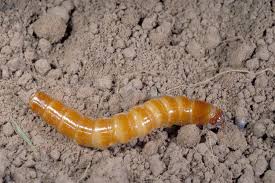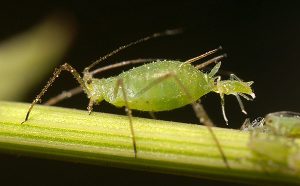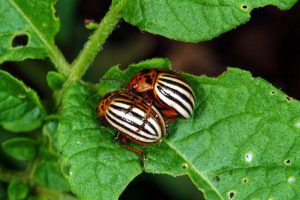Several insects enjoy waging war against potatoes by eating the tubers or leaves of the plant. These insects are often soil-dwelling pests that overwinter in the soil and come out during spring or other seasons. They are especially dangerous since they feed on the tubers, resulting in affected potatoes that are impossible to sell or even consume. Other potato bugs are foliage-eaters like the Colorado potato beetle and potato leafhopper.
- Wireworms

Wireworm
Wireworms are small, brown worms. They are the larvae of click beetles and cause serious damage to field crops such as corn and potatoes. The larvae are soil-dwelling pests which overwinter, then wage war on potatoes by burrowing into the tubers and eating the small stems of the potato plant.
Though they are about 1/16 of an inch in length when adult beetles lay the eggs, they easily mature into much bigger worms, measuring about ½ inch on average before developing into adult beetles. Since the larvae of these potato bugs takes up to 3 years to develop into adult beetles, these wireworms can cause serious damage to plants for several years. For this reason, wireworms are some of the most dangerous pests when it comes to potato crops.
- Potato Tuberworm
Like the wireworm, the potato tuberworm damages potato tubers during its larval stage. During this period of time, the damage can be extensive since not only do they bore tunnels into potato tubers but these pests also feed on potato leaves and stems. Their long, slender, and segmented bodies are perfectly designed to burrow into potatoes. They usually measure about ½ inch in length, and are whitish-yellow in color.
The potato tuberworm can cause extensive damage when the tunnels they dig into the potato tubers become infested with bacteria, mites, or fungus. This results in potatoes that are unfit for consumption.
- Potato Leafhopper
Potato leafhoppers are another dangerous pest that affects potatoes, as well as a wide variety of crops including alfalfa, beans, peanuts, and rhubarb. Adult female potato leafhoppers are green in color and

Aphid giving birth
lay up to 4 eggs per day during a reproductive period that spans about 35 days.
Within weeks, these eggs mature into what is known as the leafhopper pest. This pest affects potato plants through hopperburn. When these potato bugs feed on the leaves and other sections of the potato plant, the cells of the affected plants become damaged and begin to die. The outer layers and tips of leaves will begin to brown, a telltale sign of hopperburn. Both adults and nymphs feed on the underside of leaves.
- Aphids
Aphids are some of the most destructive pests to plant life. They feed on plant sap by using their mouth-parts called stylets. Once an aphid infestation occurs in your garden, don’t be surprised to find them attacking a wide range of plants or crops which include potatoes, papayas, apples, and peanuts. Unlike other potato pests that affect potato plants by consuming tubers, stems or leaves, aphids cause the most damage to potato crop by spreading plant diseases.
As aphids are vector of plant viruses, it’s no surprise that a species of aphids called the green peach aphid, damages potatoes by spreading what is known as the potato leafroll virus. This infection results in stunted crops that are not suited for consumption. Some infected potato species will also experience discoloration in the tuber, as well as other unfavorable symptoms.
- Colorado Potato Beetle

Colorado Potato Beetle
These ravenous pests can completely defoliate potato plants if left unchecked. The Colorado potato beetle, also known as Leptinotarsa decemlineata, feeds on plant leaves while in the adult and immature stages of its life cycle. As an adult, the beetle measures about 1/3 of an inch and is easy to identify due to the yellow and black striped pattern on its back. In the larvae stage, the bugs are reddish-brown in color and measure just a few millimeters in length.
These beetles are notorious when it comes to damaging plant crops throughout most states in the U.S. In fact, these bugs are known to be the most effective in waging war against potatoes.
- Whitefly Nymphs
The nymphs of whiteflies can be very dangerous to potatoes since they feed on potato foliage. Depending on the species, these nymphs measure about a millimeter in length and have sharp, needle-like sucking mouth-parts which they use to remove sap from plant tissues.
They may also secrete honeydew which often results in the development of black sooty mold which reduces photosynthesis and results in lower grade potato crops. An example of a whitefly species that causes such damage to potato crops is the sweet potato whitefly, also known as the Bemisia tabaci.

No Comments